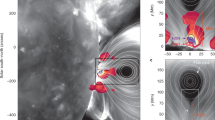Abstract
In this paper, we study the correlation between the expansion speed of two-ribbon flares and the magnetic field measured in the ribbon location, and compare such correlation for two events with different magnetic configurations. These two events are: an M1.0 flare in the quiet sun on September 12, 2000 and an X2.3 flare in Active Region NOAA 9415 on April 10, 2001. The magnetic configuration of the M1.0 flare is simple, while that of X2.3 event is complex. We have derived a power-law correlation between the ribbon expansion speed (V r ) and the longitudinal magnetic field (B z ) with an empirical relationship V r = A×B- −δ z , where A is a constant and δ is the index of the power-law correlation. We have found that δ for the M1.0 flare in the simple magnetic configuration is larger than that for the X2.3 flare in the complex magnetic configuration.
Similar content being viewed by others
References
Švestka Z. Solar Flares. Dordrecht: D. Rerdel Publ. Co., 1986
Ji H, Huang G, Wang H, et al. Converging motion of Hα conjugate kernels: The signature of fast relaxation of a sheared magnetic field. Astrophys J, 2006, 636: L173–L176
Carmichael H. A process for flares. The Physics of Solar Flares, Proceedings of the AAS-NASA Symposium held 28–30 October, 1963 at the Goddard Space Flight Center, Greenbelt, MD. Hess W N, ed. Washington, DC: National Aeronautics and Space Administration, Science and Technical Information Division, 1964. 451
Sturrock P, Coppi B. A new model of solar flares. Astrophys J, 1966, 143: 3–22
Hirayama T. Theoretical model of flares and prominences. I: Evaporating flare model. Sol Phys, 1974, 34: 323–338
Kopp R, Pneuman G. Magnetic reconnection in the corona and the loop prominence phenomenon. Sol Phys, 1976, 50: 85–98
Forbes T, Lin J. What can we learn about reconnection from coronal mass ejections? J Atmos Sol-Terr Phys, 2000, 62: 1499–1507
Poletto G, Kopp R A. Macroscopic electric fields during two-ribbon flares. In: The lower atmosphere of solar flares; Proceedings of the Solar Maximum Mission Symposium, Sunspot, NM, Aug. 20–24, 1985 (A87-26201 10-92). Sunspot, NM, National Solar Observatory, 1986. 453–465
Qiu J, Lee J, Gary D E, et al. Motion of flare footpoint emission and inferred electric field in reconnecting current sheets. Astrophys J, 2002, 565: 1335–1347
Jing J, Qiu J, Lin J, et al. Magnetic reconnection rate and flux-rope acceleration of two-ribbon flares. Astrophys J, 2005, 620: 1085–1091
Asai A, Masuda S, Yokoyama T, et al. Difference between spatial distributions of the Hα kernels and hard X-ray sources in a solar flare. Astrophys J, 2002, 578: L91–L94
Xie W, Zhang H, Wang H. Study of ribbon separation and magnetic reconnection rates in a two-ribbon flare. Sol Phys, 2009, 254: 271–283
Jing J, Chae J, Wang H. Spatial distribution of magnetic reconnection in the 2006 December 13 solar flare as observed by hinode. Astrophys J, 2008, 672: L73–L76
Lin J. Motions of flare ribbons and loops in various magnetic configurations. Sol Phys, 2004, 222: 115–136
Kitahara T, Kurokawa H. High-resolution observation and detailed photometry of a great H-alpha two-ribbon flare. Sol Phys, 1990, 125: 321–332
Asai A, Yokoyama T, Shimojo M, et al. Flare Ribbon expansion and energy release rate. Astrophys J, 2004, 611: 557–567
Fletcher L, Hudson H. The magnetic structure and generation of EUV flare Ribbons. Sol Phys, 2001, 204: 71–91
Lin J, Raymond J, van Ballegooijen A. The role of magnetic reconnection in the observable features of solar eruptions. Astrophys J, 2004, 602: 422–435
Wang H, Qiu J, Jing J, et al. Study of ribbon separation of a flare associated with a quiescent filament eruption. Astrophys J, 2003, 593: 564–570
Author information
Authors and Affiliations
Corresponding author
Additional information
Supported by the National Natural Science Foundation of China (Grant Nos. 10611120338, 10473016, 10673016, and 60673158), the National Basic Research Program of China (Grant No. 2006CB806301), the Chinese Academy of Sciences (Grant No. KLCX2-YW-T04), and the National Aeronautics and Space Administration of USA (Grant Nos. NNX0-7AH78G and NNX0-8AQ90G)
Rights and permissions
About this article
Cite this article
Xie, W., Wang, H., Jing, J. et al. The correlation between expansion speed and magnetic field in solar flare ribbons. Sci. China Ser. G-Phys. Mech. Astron. 52, 1754–1759 (2009). https://doi.org/10.1007/s11433-009-0239-2
Received:
Accepted:
Published:
Issue Date:
DOI: https://doi.org/10.1007/s11433-009-0239-2




